ARRCN Cooperative Study of Asian Raptor Migration
in Hazy Project, Japan
ABSTRACT
We investigated raptor migration for the
cooperative study of Asian raptor migration
in hazy conditions from September 1 to October 30, 1999 in
Japan. The data from 36 observation sites
from 17 NGOsí and 11 individual observers
was obtained by the end of the investigation
period. They included the data of three migratory
species: the Chinese Goshawk (Accipiter soloensis), the Oriental
Honey-buzzard (Pernis ptilorhyncus) and the Grey-faced Buzzard (Butastur indicus). About 440,000 Chinese
Goshawks were observed on Tsushima Island
from September 1 to 30. Especially,
about 340,000 birds migrated on September
25. It seems that some of these birds
migrated to Taiwan via West Kyushu. About
7,800 Oriental Honey-buzzards were
observed on Fukue-shima from September 23
to October 6. It seems that their
flocks migrated in a western direction, the
Shanghai district in China. About
32,000 Grey-faced Buzzards were observed
in Kohyama-cho, Kagoshima Prefecture
from September 27 to October 19. In addition,
it seems that most of the
Grey-faced Buzzards migrated to Taiwan via
the Miyako
Islands.
RESULTS
AND DISCUSSIONS
Data from 36 observation sites from 17 NGOs' and 11 individual observers was obtained until end of the investigation period. I will report on three important species that migrate to Southeast Asia: the Chinese Goshawk, the Oriental Honey-buzzard and the Grey-faced Buzzard.
1. Chinese
Goshawk Accipiter
soloensis
It seems that the Chinese Goshawk does not
breed in Japan. They breeds on the Korean
Peninsula and in Northeast and Southeast
China. It seems that individuals bred on
the Korean Peninsula and in Northeast China
might pass Japan during the autumn migration
period. They would start to migrate in early
September every year, on a route discovered
to be Korean Peninsula to Taiwan via West
Kyushu, Japan (Fig. 1). It is said that their
wintering area is Malaysia and Indonesia.
The migration peak of the Chinese Goshawks
generally occurred in the middle of September
in north Kyushu. Continuous observation data
at two sites was obtained (Fig. 2). About
440,000 Chinese Goshawks were observed in
Tsushima Island from September 1 to 30. Especially,
about 340,000 birds migrated on September
25. In 1999, the migration peak was extremely
delayed because of a typhoon. It seems that
some of these birds migrated to Taiwan via
West Kyushu. A new migration route from Tsushima
to Southeast China may be found in the future.
2.
Oriental
Honey-buzzard Pernis
ptilorhyncus
Oriental Honey-buzzards have bred within
wide range in Japan. They begin to migrate
in the middle of September. They were known
to migrate from the central part of Honshu
to Hukue-shima via north Kyushu (Fig. 3).
The migration peak of Oriental Honey-buzzards
usually occurs at the end of September in
north Kyushu. Vital continuous observation
data was obtained from three sites this time
(Fig. 4). About 7,800 Oriental Honey-buzzards
were observed in Fukue-shima from September
23 to October 6. It suggests that Fukue-shima
is on a main migration route of these birds,
and that most Oriental Honey-buzzards flew
away toward a western direction; the Shanghai
district in China (Inoue, 1998). It seems
that they stay at Indonesia or Malaysia for
wintering, similar to Chinese Goshawks.
3. Grey-faced
Buzzard Butastur
indicus
Grey-faced Buzzards have been known as migrating
raptor from long ago to the Japanese people.
They have bred in the forests from Kyushu
to Tohoku in Japan. They begin to migrate
in the middle of September. In the western
part of Honshu, it is known to reach south
Kyushu via two main routes; on the Inland
and the Pacific Ocean coast (Fig. 5). The
migration peak of Grey-faced Buzzards was
generally occurred middle of October in south
Kyushu. In 1999, it was on October 10 in
Kohyama-cho, Kagoshima Prefecture and on
October 16 in the Miyako Islands, Okinawa
Prefecture. About 32,000 Grey-faced Buzzards
were observed in Kohyama-cho from September
27 to October 19 (Fig. 6). It seems that
most of the Grey-faced Buzzards migrated
to Taiwan via the Miyako Islands. It seems
that they stay at Okinawa, Taiwan, the Philippines,
Indonesia, Malaysia or other unknown region
for wintering.
Fig. 1 Migration Route of Chinese Goshawks
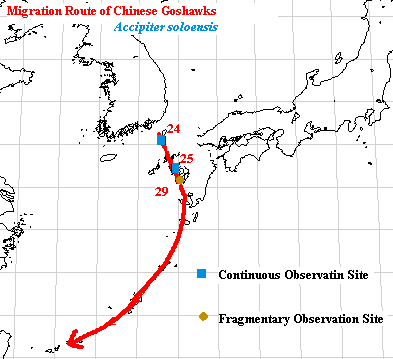
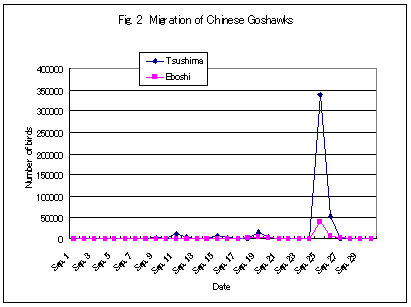
Fig.
3 Migration Route of Oriental Honey-buzzard
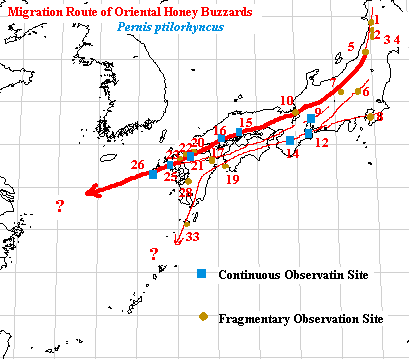
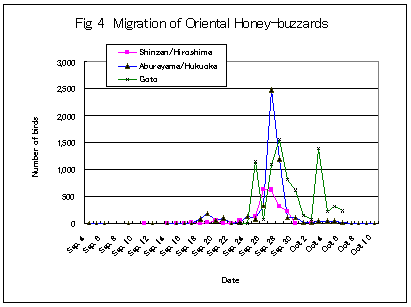
Fig. 5 Migration Route of Grey-faced Buzzard
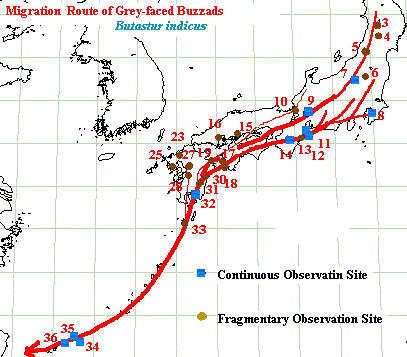
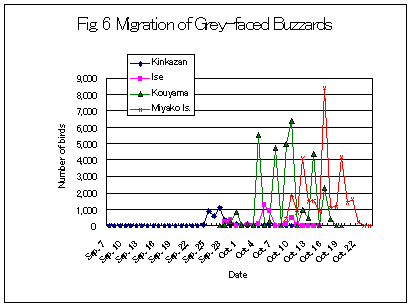
TAIWAN
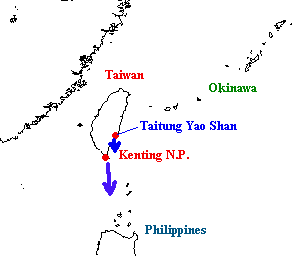

Raptor Watching in Kenting N.P.
Results
| Species | Total number | Observer | Observation period |
| Chinese Goshawk Accipiter soloensis | 42,006 | Tsai Yi-Jung | 1 Sep. - 31 Oct. |
| Grey-faced Buzzard Butastur indicus | 17,869 | Tsai Yi-Jung | 1 Sep. - 31 Oct. |
|
|
 Top |